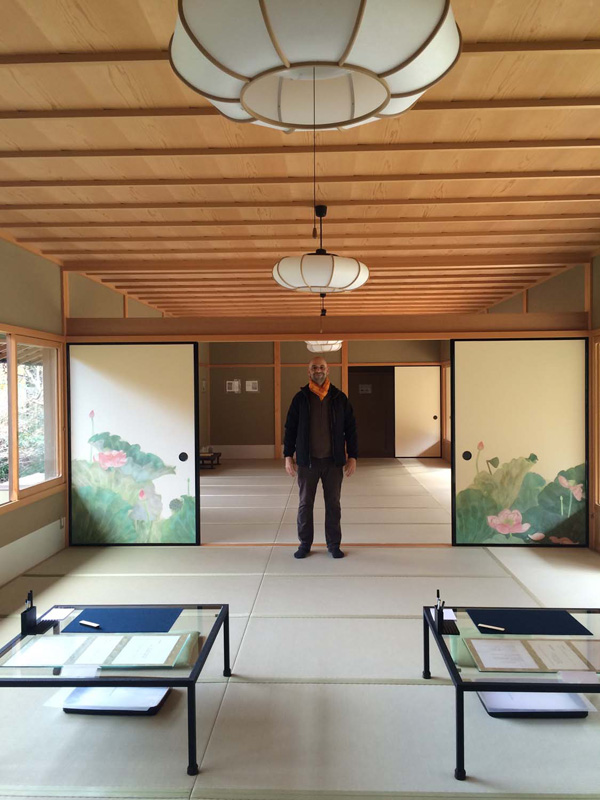Kyoto

julio
Kyoto is a constant juxtaposition of Japanese traditional and modern. Such a timeless city with more temples than you could ever see in one trip and classics that you can never visit enough. Replete with Wabi Sabi, the Japanese design and cultural aesthetic based on imperfect beauty, it is a designer and cultural creative’s dream. This city is the inspiration for some of the greatest ideas on the planet today from Steve Jobs to John Lennon - many had a long standing relationship with Kyoto. This was my first stop in Japan as an early teen and it is filled with memories and significance as my father was a huge student of all things Japanese.
The iconic Kiyomizu-dera Buddhist Temple in eastern Kyoto is stunning to visit but can get very crowded - go early or late to avoid the crowds.
The Philosopher's Walk which winds through many temples and shops between Ginkaku-ji and Nanzen-ji is an amazing place to wander around.
Christina exploring the many textures that are simply different than what our western palettes have experienced - very gooey and gelatinous.
Dressing in traditional garb is quite popular along the philosophers walk where people pose and take a lot of selfies along the way.
Typical lunch break from Lawson - the local Japanese convenience stores that sells amazing food in Japan.
We traveled up Mount Kurama, the birthplace of Reiki and came to a secluded temple. We stopped to pray and it began snowing out of nowhere. There was a fountain where you got to select a prayer and place it in the water to have the outcome magically appear. The energy up there was magical.
Julio with his fortune at Mount Kurama.
Ikebana, or the Japanese art of flower arranging, was on full display along the Temple Walk Festival at night that we were there for.
The Philosopher's walk by night...
The inside of the temples and pagodas are as beautiful as the outside. Minimal, sparse and every detail intentional and specific. The framing of the outside foliage is spectacular.
Our favorite host and spokesperson of Netflix Terrace House fame Yoshimi Tokui; also a cut-out advertisement. If you haven't seen it - check it out - it's a great look into Japanese dating and youth culture.
For Julio's birthday we went to a magnificent Okonomiyaki restaurant called Kyochabana - Okonomiyaki is a Kansai region style cabbage or noodle pancake with fixings of your choice. So delicious!
There are also many Kyoto style vegetarian buffets that are usually priced by time. Our favorite was the Obonzai Buffet at Hinataya inside Nishiki Market - a must if you are in Kyoto! It's upstairs and tricky to find but well worth it.
Nishiki Market
The famous Nishiki Market. A feast for the eyes and belly. To the left are aged bonito fish for shaving and making dashi - which is the base for Japanese cuisine including miso soup. To the right are Chirimen, small fishes used in many recipes or with rice for flavor. Their little eyes are kind of freaky.
A Kyoto delicacy that cant be missed are the delicious Japanese pickled vegetable preserves called Tsukemono. Fantastic to spice up your steamed rice and usually eaten with every meal.
Yes, this is conveyor belt sushi. Just take what looks good and stack up your plates to be counted when you leave. Delicious and fun for the price.
The timeless Gion or Geisha district. As you walk past these buildings you can see Geishas entertaining through the windows.
Temples have a Spring water fountain to cleanse or wash the hands before entering
The famous Wagyu beef with superb fat marbling due to a diet of chestnuts and constant massaging
Julio's happy place, Kinkaku-ji Temple, officially named Rokuon-ji or the Golden Pavilion
Japanese roll cakes
Our neigborhood on a lovely canal
Even the road markers are nice to look at and Kawai (cute)
We went on a day trip to Miyajima island where we found the lovers' temple or Kiezu-no-Reikado Hall. A candle is lit of a flame that has been burning for 1200 years and when placed by lovers in the temple it is said to deepen and strengthen the bond. This is also the flame they used to light the Flame of Peace at Hiroshima Peace Park which we also visited.
Traditional Japanese breakfast at the Hyatt Regency Kyoto. 5 stars!
Cucumber on a stick!
Hitting the good luck hammer at Kyumizu
No end to the Kawai or cuteness in Japan.
The Zen gardens of Kyoto such as Ryōan-ji are a spectacle of Wabi Sabi to behold and bring a full sense of calm to the mind.
Fushimi Inari Taisha is the head Shinto shrine of the fox god Inari and it is famous for its 10,000 tori gates. Inari is the principal spirit of Shinto, which is the traditional ritualistic religion of Japan and represents fertility, agriculture and prosperity
Yes we enjoyed karaoke...
Christina sings Two of Hearts
sights along the Philosopher's walk
Our morning walk from the Machiya house
A geisha going to an appointment near the Gion District
Sakura or Cherry blossoms
The most impressive selfie stick ever seen
FOOD FACTS: Kyoto's cuisine is highly inspired by Shojin ryori the traditional dining style of Buddhist monks in Japan. Shojin Ryori grew widespread in popularity with the spread of Zen Buddhism in the 13th century. The cuisine is made without meat, fish or other animal products.



















































































































